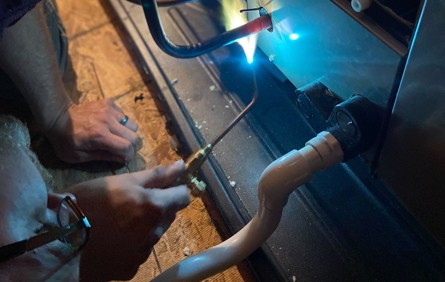Most people don’t realize how important an HVAC suction system is. They just assume that it works fine because it does work fine. But if you’ve got a problem with your suction line, then you might not even know it until it’s too late.
That’s why it’s critical to understand how these systems work before any problems arise. In this article, I’ll explain everything you need to know about a suction line so you can prevent future problems.
What is a Suction Line
There are two refrigerant lines in an air conditioning system; the liquid line and the suction line. The ac suction line is the metal tube that connects the evaporator coil located inside the outdoor unit compressor.
It’s also called a “suction line” because it creates a vacuum by pulling air through it. When the air is pulled through the line, it gets heated up and becomes less dense than the surrounding air. As a result, the air rises and moves toward the ceiling.
When the air reaches the ceiling, it hits a baffle plate and falls back down. This causes the air to move around again, creating a cycle that circulates the air throughout the entire home.
Suction lines are made of copper or steel. Copper is better at conducting electricity, so it’s often used for electrical wiring. Steel is stronger and lasts longer, so it’s usually used for pipes. Both materials are good at keeping water out. If you see rust on the surface of a suction line, it means that the line is leaking.
Most people think they don’t need to worry about HVAC suctions because they’re “just pipes.” But they’re very important. Here’s why:
1. They keep the air circulating.
2. They help prevent moisture from entering the home.
3. They reduce energy costs
4. They improve indoor air quality
Five Things you should know about an AC Suction Line.
1. How does the AC suction work?
An air conditioner works by removing heat from the inside of the house through cooling coils located outside the home. These coils are connected to the compressor unit via a suction line. When the compressor turns on, it creates a vacuum in the suction line, which pulls air into the air conditioner. Once the air is cooled, it passes back out of the air conditioner and into the house, circulating throughout the room.
While most people think of the suctions as pipes, they’re more like tubes that should be properly sized. They’re made up of multiple layers of metal, plastic, insulation, and fiberglass. Each layer serves a specific function.
2. Where is the HVAC suction Line Located?
The suction line runs along the side of the unit, near the roof. It’s usually hidden behind insulation, ducting, and other material. If you’re having trouble finding it, try looking at the backside of the unit. There should be a small hole where the suction line enters the unit.
Once you find it, you’ll see a black tube running up the side of the unit. This is the suction line. Most homes have at least one HVAC suction tube. If yours doesn’t, then you should install one. It’s very easy to do, and it won’t cost much money.
3. How often should I clean my HVAC suction lines?
It depends on the type of HVAC system you have. If you’re running a central air conditioning unit, you should clean your suction lines every month. However, if you’re running a forced-air heating system, you only need to clean them once per year. You can also check the manufacturer’s instructions for cleaning guidelines.
4. How Long do AC Suction Lines Last?
An AC suction pipe usually lasts between 10 and 25 years. However, they can last longer depending on the material used and how often your ac units are maintained. If you’re looking at replacing your existing pipes, you should call your HVAC expert.
5. The suction line should be insulated for several reasons.
-
Insulation helps prevent moisture from entering the system. Moisture can cause rusting of parts, increased energy consumption, and reduced airflow.
-
Insulating the suction line also keeps the blower from being damaged by cold temperatures. When the blower is connected to the evaporator coil, it draws air through the suction line. If the suction line is not insulated, the blower may freeze due to the low temperature outside.
-
Insulating the lines also prevents noise from traveling throughout the house. Noise travels through pipes and hoses, causing vibrations that damage walls and ceilings.
-
Finally, insulation protects the suction line from the elements. If the suction lines are not protected, they can become brittle and break, causing leaks in the system.
Problems Associated with a Suction Line
The most common problem associated with a suction line is clogging. This happens when the air filter gets blocked due to the accumulation of dust or debris. When this happens, the airflow through the system decreases. As a result, the temperature inside the room increases. This increase in temperature causes the air conditioner to work harder.
Another problem associated with clogged air filters is that they may cause damage to the compressor. This results in increased energy consumption. Therefore, installing a suction line filter drier close to the compressor is essential.
What is a Suction Line Filter Drier
A suction-line filter drier (SLFD) is a device that removes moisture from the air being sucked into the home by the HVAC system. If the SLFD isn’t working properly, it could cause damage to the HVAC system itself.
Filter driers often fail because they’re clogged up with dust and debris. This makes them ineffective at removing moisture from the air. So, you should perform routine maintenance on your suction line filter.
You can do this yourself or hire a professional to come to check them out. Either way, it’s best to schedule regular service calls to keep your HVAC system running smoothly.
Regular Maintenance with Hurliman Heating
Keeping up with routine AC maintenance is the best way to avoid frozen suction lines. Scheduling an annual service appointment with your HVAC technician in Spokane, VA, keeps your coils clean, your filters clear, and your AC running smoothly. Regular maintenance helps you save money on energy bills.
Contact us today if you need help keeping your AC suction line in perfect condition!






